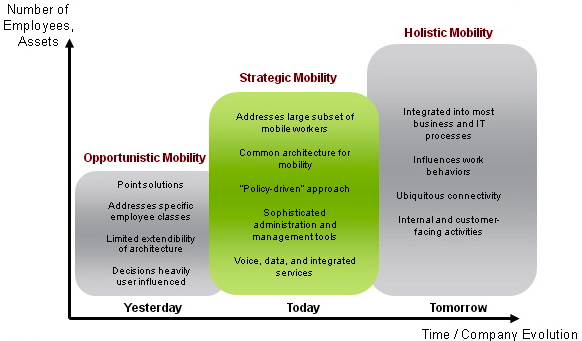At a recent webinar (March 2010) sponsored by AT&T, Gene Signorini, Yankee Group’s Vice President of Mobility presented the case for mobility. First, that mobility applications were top priority among some 562 survey respondents and secondly that this priority reflected an increase in the strategic importance of mobility services and applications.

This graphic shows the rank ordering of priorities, courtesy of Yankee Group, 2010. Two of the top 3 priorities are mobile – mobile-enabled apps and smartphones. Of course, it is important to note (and unfortunately Yankee did not mention this), that the Margin of Error for a panel this size is +/- 4%, which says that the intervals between these top three choices are hardly distinct and could just as easily be collaboration apps and then mobile-enabled apps as it could be the order shown.
Anyways, given the priority, Gene then went on to explain why mobility is a priority for enterprises.
He used the graphic below to discuss the three stages of mobility deployments: the Opportunistic Mobility, the Strategic Mobility and in the future the Holistic Mobility deployment. In the Opportunistic stage, decisions are characterized by their point solution-orientation, heavy dependence on user decision making and tightly focused on specific classes of employees or departments.
The Strategic stage delivers an integrated service model, policy-driven approaches and leverages a common architecture across geos and user groups.
In the future, the Holistic stage has the mobility service completely integrated into the business and IT processes. Mobility influences work behaviors and leverages ubiquitous wireless connectivity.







